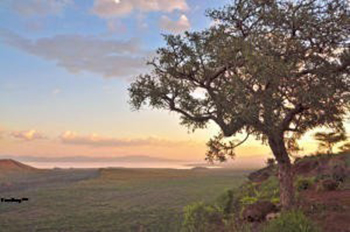The bipedal human ancestor or the grassland encroaching on the forest? A new analysis of the past 12 million years’ of vegetation change in the cradle of humanity is challenging long-held beliefs about the world in which our ancestors took shape — and, by extension, the impact it had on them.
The research combines sediment core studies of the waxy molecules from plant leaves with pollen analysis, yielding data of unprecedented scope and detail on what types of vegetation dominated the landscape surrounding the African Rift Valley (including present-day Kenya, Somalia and Ethiopia), where early hominin fossils trace the history of human evolution,according to Science Daily.
“It is the combination of evidence both molecular and pollen evidence that allows us to say just how long we’ve seen Serengeti-type open grasslands,” said Sarah J. Feakins, assistant professor of Earth sciences at the USC Dornsife College of Letters, Arts and Sciences and lead author of the study, which was published online in Geology on Jan. 17.
Feakins worked with USC graduate student Hannah M. Liddy, USC undergraduate student AlexaSieracki, Naomi E. Levin of Johns Hopkins University, Timothy I. Eglinton of the EidgenössischeTechnischeHochschule and RaymondeBonnefille of the Universitéd’Aix-Marseille.
The role that the environment played in the evolution of hominines — the tribe of human and ape ancestors whose family tree split from the ancestors of chimpanzees and bonobos about 6 million years ago — has been the subject of a century-long debate.
Among other things, one theory dating back to 1925 posits that early human ancestors developed bipedalism as a response to savannas encroaching on shrinking forests in northeast Africa. With fewer trees to swing from, human ancestors began walking to get around.
While the shift to bipedalism appears to have occurred somewhere between 6 and 4 million years ago, Feakins’ study finds that thick rainforests had already disappeared by that point — replaced by grasslands and seasonally dry forests some time before 12 million years ago.
In addition, the tropical C4-type grasses and shrubs of the modern African savannah began to dominate the landscape earlier than thought, replacing C3-type grasses that were better suited to a wetter environment. (The classification of C4 versus C3 refers to the manner of photosynthesis each type of plant utilizes). While earlier studies on vegetation change through this period relied on the analysis of individual sites throughout the Rift Valley — offering narrow snapshots — Feakins took a look at the whole picture by using a sediment core taken in the Gulf of Aden, where winds funnel and deposit sediment from the entire region. She then cross-referenced her findings with Levin who compiled data from ancient soil samples collected throughout eastern Africa.
“The combination of marine and terrestrial data enable us to link the environmental record at specific fossil sites to regional ecological and climate change,” Levin said.
R.S

